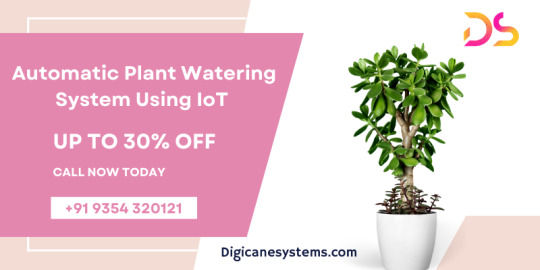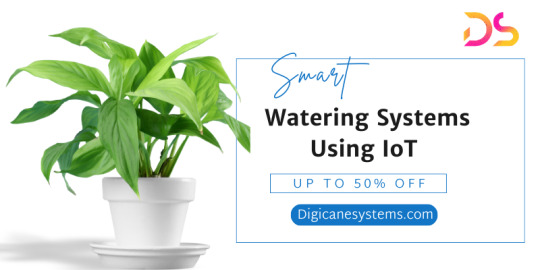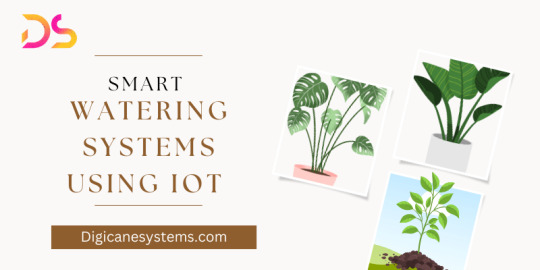Digicane Systems, use a blend of software and hardware solutions to monitor, control and conserve energy consumption, smart watering system by iot, and many more.
Don't wanna be here? Send us removal request.
Text
Smart Irrigation Systems using IoT And How Do They Work? Digicane Systems
Monitor Your Irrigation System with Tablet
Reduced water consumption is one of the best ways to combat climate change-related water shortages. However, it can be challenging during droughts or for growers who use conventional irrigation systems as they do not have a precise way to measure and control their water usage.
Smart Irrigation Systems using IoT allow growers to track and optimize water consumption. This ensures that you do not waste water, or give it away in excess. This article describes Smart Irrigation Systems using IoT, their working, and how they help to address water shortages.

What Is A Smart Irrigation System?
You can integrate Smart Watering Systems using IoT into your existing irrigation system. They monitor, analyze and automate your water usage, reducing waste, detecting leaks and alerting you to any potential problems.
Instead of relying on manual watering methods, you can create an irrigation schedule based on the real-time requirements of your plants by using a smart watering system that is connected to all water related operations. This reduces runoff, erosion and evaporation, which helps to conserve water.
Smart Irrigation Systems using IoT: How They Work
In traditional irrigation, the grower manually opens and closes valves when needed. Smart water technology uses smart water valves that are embedded in your drip irrigation system to track water usage and allow you to control it remotely.
A smart water control valve has a valve controller and flow meter. It also contains wireless connectivity and power. The smart water valve collects data from flowmeters that measure the flow of water through your irrigation system. The smart valve then transmits this information via wireless to a cloud-managed software platform. You can then access the data from your computer or phone at anytime and anywhere.

Smart Water Technology: Resist Water Shortages
Growers can take proactive measures to reduce their impact on the environment while we are working to reduce our carbon footprint by using methods like efficient transport and renewable energies. Smart water technology helps to avoid water shortages in several ways.
Leak Detection
A leaking irrigation system can cost up to 6,300 gallons per month. Leaks of this nature can have a negative impact on your water supply, and you may even lose water during times of drought. Leaks are the easiest way to reduce water consumption and monitor your supply.
The technology of leak detection gives you instant access to your most precious resource. It is possible to reduce water consumption on a farm without having to pay large upfront costs or shut down maintenance processes.
Measurement
Good data is the key to smart irrigation decisions. You can improve your water management by making sure that your irrigation system is equipped with smart sensors and controls.
Smart sensors in real-time allow you to determine the amount of water being used and where. Smart irrigation technology allows growers to be aware of how much water their crops have received. This gives them full visibility to where their water has been used, so they can take proactive measures to address any unplanned deviations in their irrigation schedules.
You can also find out more about the Automated Vehicles by clicking here.
Although irrigation timers and controllers are not a new idea, their cost, complexity and reliability have prevented them from being widely adopted. Automation is now much easier to use and more affordable with modern systems. You will never again overwater your plants by automating your irrigation. The valves will automatically shut off once the exact volume has been reached. You'll also save labor costs, since you won't have to hire someone to oversee and operate each valve.
For crops such as almonds, strawberries and wine grapes where water conservation is a major challenge, improved irrigation management can save up to 20 percent of the total water consumed.
Harnessing Real-Time Data
Growers need to be able to analyze data in real-time. There are a number of data solutions available to determine the optimal water schedule for crops, such as:
Soil Moisture Sensors
Plant Sensors And Pressure Chambers
Weather Stations
Satellite Imagery
Smart Watering Systems based on IoT often integrate these external data sources so that growers can create and manage their irrigation schedules in a single dashboard, and make adjustments easily, without having to jump from app-to-app.

Preventive Maintenance
Smart irrigation technology detects problems by automatically monitoring water pressure and flow. You'll be able to detect problems before they turn into costly or dangerous situations. Leaks and clogs are the main causes of water waste in farming.
Sensor technology, data and automation allow growers to optimize irrigation to a new level. All these factors working together in harmony allows you to distribute water where it is needed and prevent waste.
Smart Irrigation Systems using IoT not only save growers time and money but can also reduce the amount water required for their crops while still achieving the same or better results.
How To Get Started With Modern Solution
Conserving water is essential for reducing the impact of climate change. Using water more efficiently is one way to achieve this. Smart Irrigation Systems using IoT allow growers to use less water for irrigation without risking their crops or livelihoods. We believe that conserving natural resources requires every drop to be counted. We have created a smart irrigation solution that allows you to automate your water use and track it in a simple way. Call us to find out how we can make irrigation easier and more efficient.
#smart irrigation system#smart irrigation system based on IoT#Smart irrigation system using IoT ppt#Smart watering system using IoT in india#Smart watering system using IoT pdf#Smart watering system using IoT project#Smart Watering systems based on IoT#Smart Watering systems with IoT#Smart Watering Systems using IoT#Smart watering system using IoT project report pdf#Smart watering system using IoT project report
0 notes
Text
Smart Watering System Using IoT Digicane Systems
0 notes
Text
Smart Watering System Using IoT Digicane Systems Smart watering system using iot use sensors and data analytics to accurately monitor soil moisture and plant water needs. This allows the system to supply the required amount of water, reducing water wastage and promoting sustainable practices. With a smart irrigation system based on IOT, you can schedule and control watering from anywhere using a mobile app or web interface. This eliminates the need for manual adjustments and ensures your lawn and garden are always watered, even when you're not home. For More information - https://digicanesystems.com/smart-watering-system-using-iot/
0 notes
Text
Smart Watering System Using IoT Digicane Systems Smart watering system using iot use sensors and data analytics to accurately monitor soil moisture and plant water needs. This allows the system to supply the required amount of water, reducing water wastage and promoting sustainable practices. With a smart irrigation system based on IOT, you can schedule and control watering from anywhere using a mobile app or web interface. This eliminates the need for manual adjustments and ensures your lawn and garden are always watered, even when you're not home. For More information - https://digicanesystems.com/smart-watering-system-using-iot/
0 notes
Text
Building the Future with Intelligent Energy Management Systems
Intelligent Energy Management Systems
With concerns like the depletion of traditional energy sources and climate change growing at a rapid pace, it has become critical to manage energy resources efficiently. And what better way to do this than using an intelligent energy management system? An all-inclusive approach to optimizing energy consumption and reducing carbon footprint, such systems are now being widely used in homes, industries and commercial buildings.
Smart energy management systems, like those available from Digicane Systems, use a blend of software and hardware solutions to monitor, control and conserve energy consumption by collecting energy usage data and analysing patterns. Gathered data is further used to make informed decisions that enhance energy efficiency and reduce wastage.

Challenges of Using Inefficient Energy Management Systems
Inefficient and obsolete energy management systems face several challenges, like:
High initial setup costs, especially for homeowners and smaller businesses. That's a major reason why such systems are not adopted on a wide scale.
Interoperability problems due to the availability of different EMS products from varied vendors. This hinders seamless data integration and exchange.
Unauthorised access to energy usage data leads to privacy and data security concerns, resulting in several malicious activities.
Conversely, the use of modern-day, efficient and intelligent energy management systems can reduce energy consumption, increase reliability, predict the performance of electrical systems and optimise energy usage to reduce costs.
Understanding the Usefulness of Today's Intelligent Energy Management Systems
The current generation of smart energy management systems, like those available from Digicane Systems, are more than just manual monitoring methods. They are highly advanced EMS solutions comprising data management servers and several energy meters closely connected to a network using a server. Such systems put Overall Equipment Effectiveness systems in place and determine Key Performance Indicators by comparing actual equipment availability, quality losses and performance to maximum predicted performance.
With real-time OEE visibility, such systems empower users to visualise their energy consumption patterns and take corrective actions quickly. These may include setting energy-saving targets and implementing automated controls for heating, cooling, lighting and other electronic devices. Additionally, such systems help users manage central data, visualise stored records and extract live data from connected devices.
Industries can use modern-day smart energy management systems to save around 35% of energy that is otherwise lost in the industrial environment due to ineffective machinery. These industrial-grade, automated energy management solutions monitor connected instruments and devices continuously and alert systems with alarms and notifications. Besides optimizing energy consumption, this contributes to a more reliable and stable grid system.
Work Principle of Intelligent Energy Management Systems
By reading energy usage data and by monitoring daily, weekly and monthly energy consumption patterns, intelligent energy management systems help achieve and maintain energy procurement and use. The system works in the following way:
The intelligent energy management system is linked to the RS485 network using the IDM server. Note that the system is also compatible with other networks.
Next, it collects data from the energy meters and transfers it to the cloud server with the help of a data logger.
Henceforth, collected data is processed and is only accessible by an authorised individual.
This processed data plays an important role in understanding energy consumption behaviour. Through this available data, users can further take steps to rectify undesired energy usage and save energy that can be used for varied business procedures.
Conclusion
So, there you are! An intelligent energy monitoring system makes it easy to acquire, understand and act upon energy data, so missed insights do not become missed opportunities for home and commercial space owners. At Digicane Systems, their mission is to make spaces more sustainable, energy-efficient and affordable to operate. If you are interested in their intelligent energy management solutions, contact them now!
#intelligent energy management system#intelligent energy management#energy management#Intelligent Energy Management#Digicane Systems#smart energy management systems#smart electricity management systems#electricity management systems
0 notes